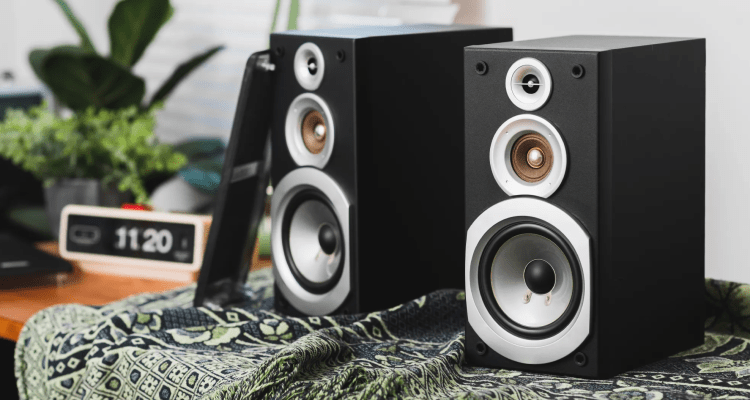Short answer: kind of—but probably not as much as the internet says. Think of new speakers like new sneakers. They’re totally wearable on day one, but after a handful of walks they feel a touch looser, more comfortable, and a bit less squeaky. Speakers can behave the same way: a little change early on, then they basically are what they are.
What “break-in” actually means (and what it doesn’t)

- The suspension loosens slightly.
Every woofer has a flexible surround (the ring around the cone) and a spider (a corrugated disk inside the driver). In the first hours of play, those parts can relax a bit. The result can be a hair more bass warmth and an easier “flow” at moderate volumes. - Tweeters change very little.
Dome tweeters don’t move much air, so any mechanical settling is minimal. If you notice a change up top, it’s more likely your ears acclimating or the rest of the system/room doing its thing. - Crossovers don’t “magically open up.”
The coils, resistors, and capacitors in a passive crossover aren’t doing yoga stretches. They’re mostly stable from the jump. Any talk of huge crossover transformations is… optimistic. - Ferrofluid just warms up while playing.
Some tweeters use ferrofluid for cooling/damping. It thins a touch when warm, but that’s a session-by-session warm-up, not a multi-week metamorphosis.
Related: How Bookshelf Speakers Compare to Floorstanding Speakers
How much difference should you expect?
- Small but real, mostly down low.
The most believable change is a slight increase in bass output and a touch more ease through the midbass after 10–30 hours of normal listening. If your speakers sounded thin on hour 1, they might feel a bit fuller by hour 20—but don’t expect a subwoofer to grow in there. - Room and placement beat break-in—every time.
A two-inch move from the back wall, a tiny toe-in tweak, or raising the tweeters to ear height will typically dwarf any break-in effect. Treat the room and nail placement first. - Your ears adapt.
Part of “break-in” is you. After a few evenings, your brain builds a new “reference.” That alone can make things seem smoother and more natural.
How long is the break-in period?
- Practical window: 10–50 hours.
Many manufacturers suggest something in that range. Most bookshelf speakers sound 90–95% like themselves right out of the box and settle the rest over a few days of normal listening. - If you’re still unhappy after ~50 hours, look elsewhere.
Break-in won’t fix a fundamental mismatch (bright room, underpowered amp, placement issues, or a tonal balance you just don’t like).
A safe, simple break-in plan
- Play real music at moderate levels.
Shuffle through bass-rich and vocal tracks for variety. You want the woofers moving, but no rattles, no clipping. - Don’t blast overnight.
Pink noise or “break-in tracks” aren’t necessary. If you use noise, keep it moderate and check on it—your neighbors and voice coils will thank you. - Give them air and support.
Put the speakers on sturdy stands, tweeters near ear height, and start with 6–18 inches from the rear wall. Small tweaks here matter far more than running them for 200 hours.
Troubleshooting: break-in won’t fix these
- Harshness at any volume: likely room reflections, aggressive recordings, or too much toe-in. Try aiming the speakers slightly past your shoulders, not directly at your nose.
- Flabby bass: speaker too close to a corner or a boomy room mode. Pull them forward, shift left/right a few inches, or experiment with a plug in the port (if your model allows).
- Weak dynamics: check amplifier power and speaker sensitivity. Some bookshelves love a beefier amp.
- Hollow vocals: verify polarity (red-to-red, black-to-black) on both speakers.
Quick checklist for day-one great sound
- Height & angle: tweeters at ear level; toe-in until the center image “locks” without sounding sharp.
- Distance: start with the speakers 6–9 feet apart and your seat forming a loose triangle.
- Wall spacing: leave breathing room behind them; adjust in 1–2 inch steps to balance bass and clarity.
- Sub integration (if used): cross around 70–90 Hz for small bookshelves, then trim sub level until it disappears but you miss it when it’s off.
- Run auto-cal (if you have it): then trust your ears and tweak 1–2 dB on the center/treble/bass as needed.
Do powered/active monitors need break-in?
A little suspension settling can still happen, but active speakers often sound very consistent right away. Their built-in amps and DSP are tuned to the drivers, which reduces the “variables” you fight with in passive setups.
The bottom line
Yes, bookshelf speakers can loosen up a bit in the first 10–50 hours, mostly in the bass and overall ease. But the big wins come from placement, room acoustics, and proper amplification—not from waiting weeks. Set them up well, enjoy your music now, and let whatever tiny break-in happens… happen in the background while you’re smiling.
